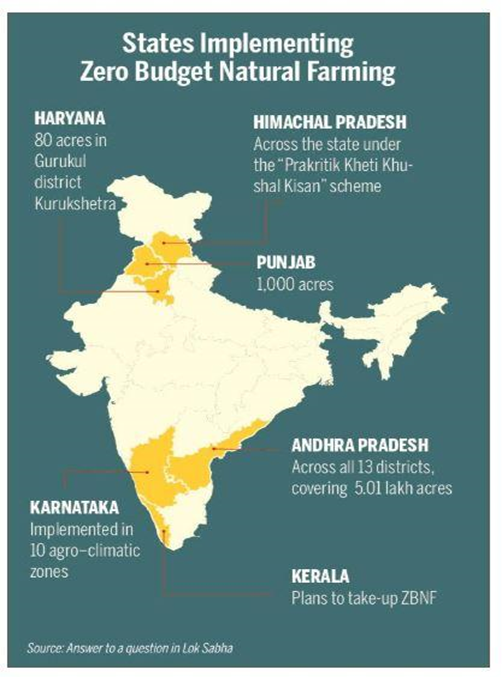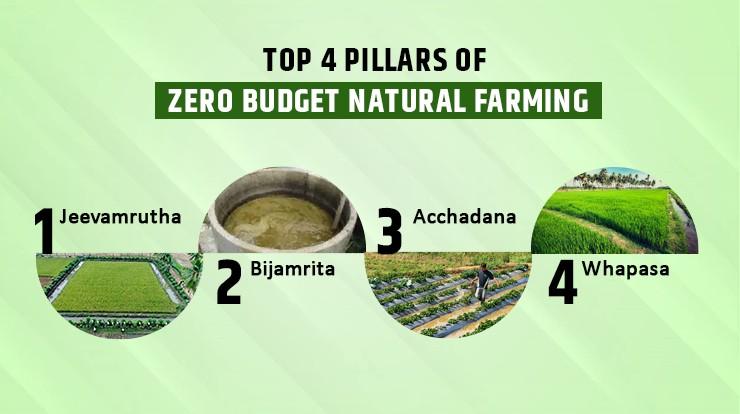- Courses
- GS Full Course 1 Year
- GS Full Course 2 Year
- GS Full Course 3 Year
- GS Full Course Till Selection
- Online Program
- GS Recorded Course
- NCERT (Recorded 500+ Hours)
- Polity Recorded Course
- Geography Recorded Course
- Economy Recorded Course
- AMAC Recorded Course
- Modern India, Post Independence & World History
- Environment Recoded Course
- Governance Recoded Course
- Science & Tech. Recoded Course
- International Relations and Internal Security Recorded Course
- Disaster Management Module Course
- Ethics Recoded Course
- Essay Recoded Course
- Current Affairs Recoded Course
- CSAT
- 5 LAYERED ARJUNA Mentorship
- Public Administration Optional
- ABOUT US
- OUR TOPPERS
- TEST SERIES
- FREE STUDY MATERIAL
- VIDEOS
- CONTACT US
Revolutionizing Indian Agriculture through Natural Farming
Revolutionizing Indian Agriculture through Natural Farming

Revolutionizing Indian Agriculture through Natural Farming
Background
1. Natural Farming is a method of agriculture that relies on natural processes rather than synthetic inputs.
2. In India, it has gained popularity as a way to increase crop yields and reduce the environmental impact of agriculture.
3. However, there are a number of challenges that natural farmers in India face like limited market, lack of readily available natural inputs and decline in yields due to climate change.
4. As a result, it is crucial to study these challenges from a micro perspective, and to promote natural farming as a food production method that is eco-friendly and does not compromise the needs of future generations.
So, What is Natural Farming?
1. ‘Natural Farming’ is suggested as a modern approach to improve both traditional and modern agricultural practices.
2. It aims to safeguard the environment, public health, and communities.
3. Natural Farming aims to significantly cut down production costs by encouraging farmers to prepare essential biological inputs using on-farm, natural and home-grown resources.
4. It has the potential to enable food production without compromising the needs of future generations.
About the Significance of Natural Farming
1. Natural Farming helps in increasing net incomes of farmers by reducing the input cost while maintaining the adequate production.
2. The food produced from Natural Farming has higher nutrition value and therefore offers better health benefits.
3. As Natural Farming does not use any synthetic chemicals it helps in reducing health risks.
4. The Natural Farming has a very healthy impact on the biology of soil or on microbes. It improves soil health and in turn increase productivity.
What are the Major Challenges Related to Farming in India?
1. Even after taking significant steps, many farmers still depend on the monsoon as only 52 % of India's Gross Cropped Area (GCA) is irrigated at the national level.
2. Despite of the rapid commercialization of agriculture in India, most farmers stick to cereals as the main crop and ignore crop diversification.
3. Farmers often talk about the lack of readily available natural inputs as a barrier to converting to chemical-free agriculture as not every farmer has the time, patience, or labour to develop their own natural inputs.
4. Many farmers have switched back to conventional farming after seeing the reduced yield out of ZBNF.
5. Sikkim, the 1st organic state in India has seen some declines in production after they shifted to organic farming.
What is Zero Budget Natural Farming?
1. It is a unique model of farming that depends on Agroecology. Agroecology is sustainable farming that works with nature.
2. It uses chemical-free farming based on sustainable agricultural practices.
3. In the mid-1990s, Subhash Palekar has developed it as an alternative to the chemical fertilisers, pesticides and intensive irrigation methods, which have helped during Green Revolution.
4. It aims to reduce the production costs and return to pre-green revolution farming practices which do not require expensive inputs such as fertilisers, pesticides, and irrigation.
|
Jeevamrutha |
Cow dung+ Aged Urine (Desi cow) +Pulse Flour + Jaggery + Farm Oil This mixture is one type of natural fertilizer which applied to farmland. |
|
Beejamrutha |
Cow dung + Aged urine (desi cow) + Lime + Farm Soil. It provides natural protection to seeds. |
|
Acchadana |
It helps to maintain soil moisture content. This pillar helps to protect the cover of soil cultivation and does not ruin it by tilling. |
|
Whapasa |
It is a condition where water molecules and air molecules are present in the soil. It helps to reduce the extra irrigation requirement. |
What is the difference between Zero Budget Natural Farming and Conventional Farming?
|
Zero Budget Natural Farming |
Conventional Farming |
|
Almost Zero cost |
High Input and Operational Cost |
|
Jeevamrutha and other methods are applied |
Fertilizers are used |
|
No ploughing and tilting needed |
Ploughing and tilting needed |
|
Less irrigation requirement |
It is Irrigation intensive |
|
Based on ecology |
Based on economics |
What are the Recent Government Initiatives Related to Sustainable Agriculture?
- National Mission on Sustainable Agriculture
- Paramparagat Krishi Vikas Yojana (PKVY)
- Sub-mission on AgroForestry (SMAF)
- Rashtriya Krishi Vikas Yojana
- Mission Organic Value Chain Development for North Eastern Region (MOVCDNER)
Way Forward
1. Government should work to increase the women’s Participation in Natural Farming, as their involvement in decision-making would also positively impact the health and nutritional status of the family.
2. Traditional technologies can be used to complement frontier technologies like tissue culture, genetic engineering, to achieve higher productivity. Rainwater harvesting and recycling of organic waste for plant nutrient, pest management, etc., are examples of traditional technologies.
3. Government should support the microenterprises that produce inputs for chemical-free agriculture to address the challenge of unavailability of natural inputs.
4. The promotion of natural farming needs to be combined with the setting up of village-level input preparation and sales shops.
Additional Information
What are Organic Fertilizers?
- An organic fertilizer is a fertilizer that is derived from organic sources, including organic compost, cattle manures, poultry droppings and domestic sewage etc
- Organic fertilisers can be categorised into 2 segments and these are: Biofertilizers and Organic Manure.
- Bio-fertilizers:
- Bio-fertilizers composed of living microorganisms which are attached to solid or liquid carriers and are useful for cultivable land, as these micro-organisms helps in increasing the productivity of soil.
- Examples: Rhizobium, Azospirilium, Azotobacter, Phosphobacteria, Blue Green Algae (BGA), Mycorhiza, Azolla.
- Organic manure:
- Organic manure, on the other hand, refers to partially decomposed organic matter like digestate from a biogas plant, compost and vermicompost, which provides nutrients to the soil / crops and improves yield.
What is the Potential of Organic Fertilisers in India?
- Utilizing Municipal Solid Waste:
- India produces more than 150,000 tonnes of municipal solid waste (MSW) each day.
- After considering collection efficiency of 80% and organic part of MSW to be 50%, total organic waste generated per day in India comes to around 65,000 tonnes per day.
- Even if half of this is diverted to the biogas industry, the government can leverage this by reducing in import of fossils and fertilisers.
2. Utilizing Biogas Effluents:
A) There is also a great value in the organic fertiliser also known as ‘digestate’, which is the biogas plant's effluent.
B) This Biogas can be utilised for heating, electricity and even vehicular purposes (after upgrading).
3. Increases Soil Fertility:
A) Digestate can provide organic carbon to the continuously depleting soil, apart from its standard nutrition value.
B) At present, India’s bio-fertiliser production is just over 1,10,000 tonnes (carrier-based 79,000 tonnes and liquid-based 30,000 tonnes) and 34 million tonnes of organic manure, composed of farmyard manure, city compost, vermicompost etc.
4. Organic Farming getting more popular:
A) The popularity of organic farming has grown in the domestic market in recent years.
B) The market size for Indian organic packaged food is expected to grow at a rate of 17%.
C) The significant rise of this sector is linked to growing awareness about the harmful effects of synthetic fertiliser on soil, rising health concerns, expanding urban population base and an increased consumer expenditure on good quality food items.




